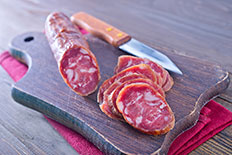Meats and Sausages
Salame Brianza
Salame Brianza PDO can only be produced in Lombardia, Emilia Romana and Piemonte regions of Italy. The alpine range that forms the north-west border of the Brianza area brings special climatic conditions to the whole Piedmont region: air currents and weather systems are filtered by mountain ranges, warm down-slope winds, cold winds (when the currents blow from the north and fog produce the right conditions for the development of microbial flora and fermenting, drying and ageing sausages.
| Meats | Metric | US |
|---|---|---|
| Lean pork (shoulder) | 700 g | 1.54 lb |
| Back fat | 300 g | 0.66 lb |
Ingredients per 1000g (1 kg) of meat
| Salt | 28 g | 5 tsp |
| Cure #2 | 3.0 g | 1/2 tsp |
| White pepper | 2.0 g | 1 tsp |
| Black peppercorns | 4.0 g | 2 tsp |
| Dextrose | 3.0 g | 1/2 tsp |
| Garlic powder | 3.0 g | 1/2 tsp |
| White wine | 15 ml | 1 Tbsp |
| T-SPX culture | 0.12 g | use scale |
Instructions
- Grind lean pork through 1/4” (6 mm) plate.
- Dice fat into 1/4” (6 mm) cubes.
- 30 minutes before mixing dissolve starter culture in 1 tablespoon de-chlorinated water.
- Mix lean pork with salt and cure #2. Add spices, wine and culture. Add diced fat and mix all together.
- Stuff firmly into 40 mm hog casings.
- Ferment at 20º C (68º F) for 72 hours, 90-85% humidity.
- Dry at 9-13° C (48-56° F) for 3 weeks.
- Store at 10-12° C (50-55° F), 75% humidity.
Notes
The name of the protected designation of origin ‘Salame Brianza’ must appear on the label in clear and indelible letters, fully distinguishable from any other wording, and must be followed immediately by the term ‘Denominazione di Origine Protetta’ [Protected Designation of Origin].
The geographical area of production
The production area for ‘Salame Brianza’ PDO is located in the Brianza region, bordered to the north by the Ghisallo foothills, to the south by the Villoresi canal, to the east by the deep course of the Adda river, and to the west by the Comasina trunk road (including a 2 km outer ring). The characteristics and natural resources of the macro-zone have in fact enabled the considerable expansion of agriculture and livestock farming, shaping the economic activities in the area today, with a major maize-growing industry and numerous feed manufacturers transforming cereal crops into feed for the huge number of pig and cattle farms in the zone. Detailed rules on the use and composition of the animals’ diet must be respected. Pigs are fed in two stages, and their feed mainly consists of cereal products. By-products from cheesemaking (whey, curds and buttermilk) are supplied by dairies located within the defined geographical area.
Production
Pig farms producing meat for ‘Salame Brianza’ must be located in the Brianza region.
Meat: pork shoulder, leg trimmings (ham part), pork trimmings, pork belly, jowls.Ingredients: salt, crushed and/or ground pepper, sugar and/or dextrose and/or fructose and/or lactose, starter cultures, sodium and/or potassium nitrate (maximum quantity: 195 parts per million), sodium and/or potassium nitrite (maximum quantity: 95 parts per million), ascorbic acid and its sodium salt, and a very small amount of garlic.
Processing: Meat can be ground through 4-4.5 mm (3/16”) or through 7-8 mm (3/8”) grinder plate. Ground meat is mixed with all ingredients and stuffed into natural or synthetic casings, which can have diameter from 40mm to 110 mm or even more (1.75 - 4” or even more). Very large sausages will need to be reinforced with hemp or cotton twine or placed into netting. Stuffed sausages are placed for a few days in a chamber at 15 - 25° C (59 - 77° F) where they will ferment and dry. Then they will be submitted to drying/maturing step at 9 - 13° C (48 - 55° F). Depending on diameter the sausages will mature from 14 days (up to 43 mm) to 90 days (up to 110 mm diameter).


















